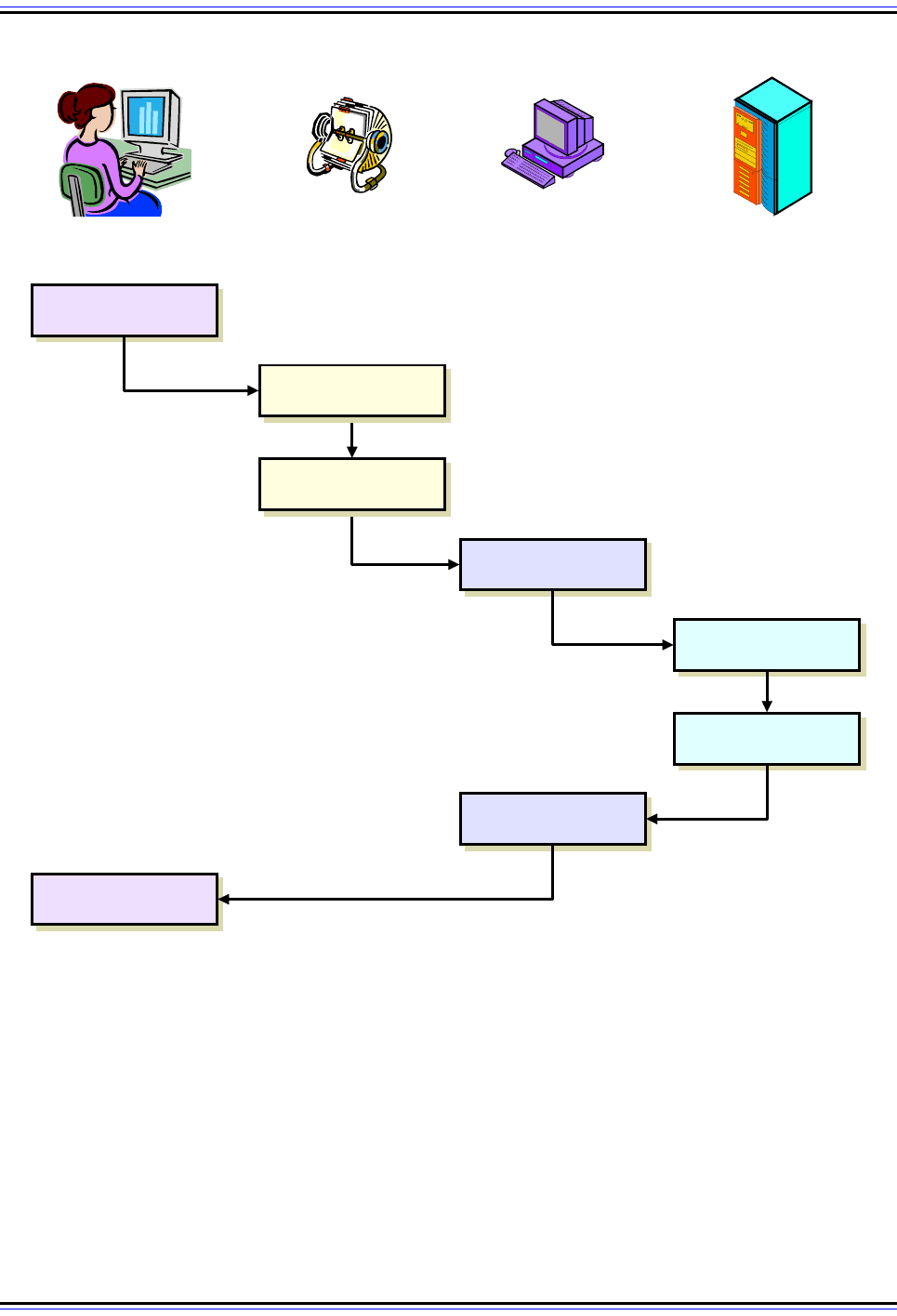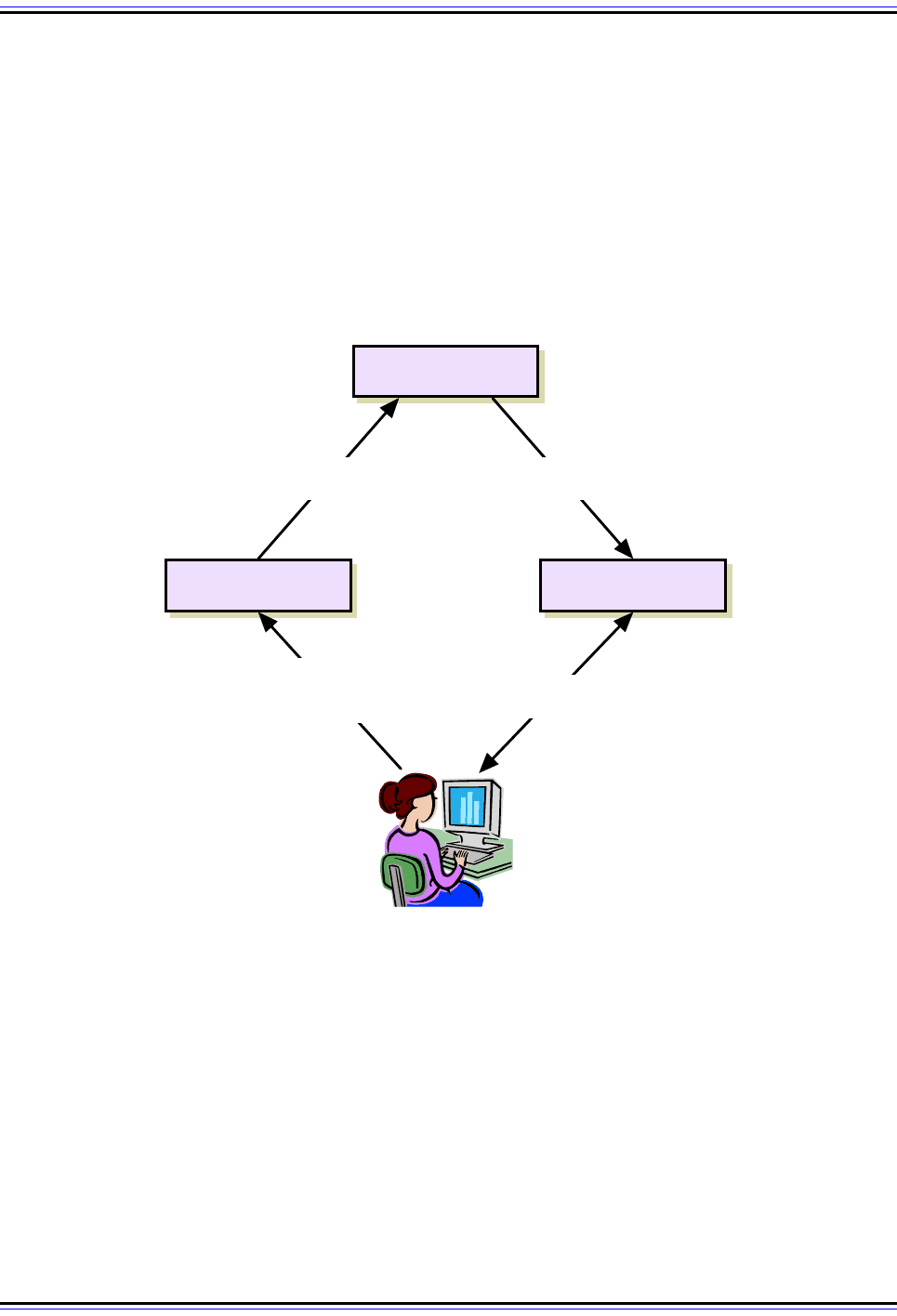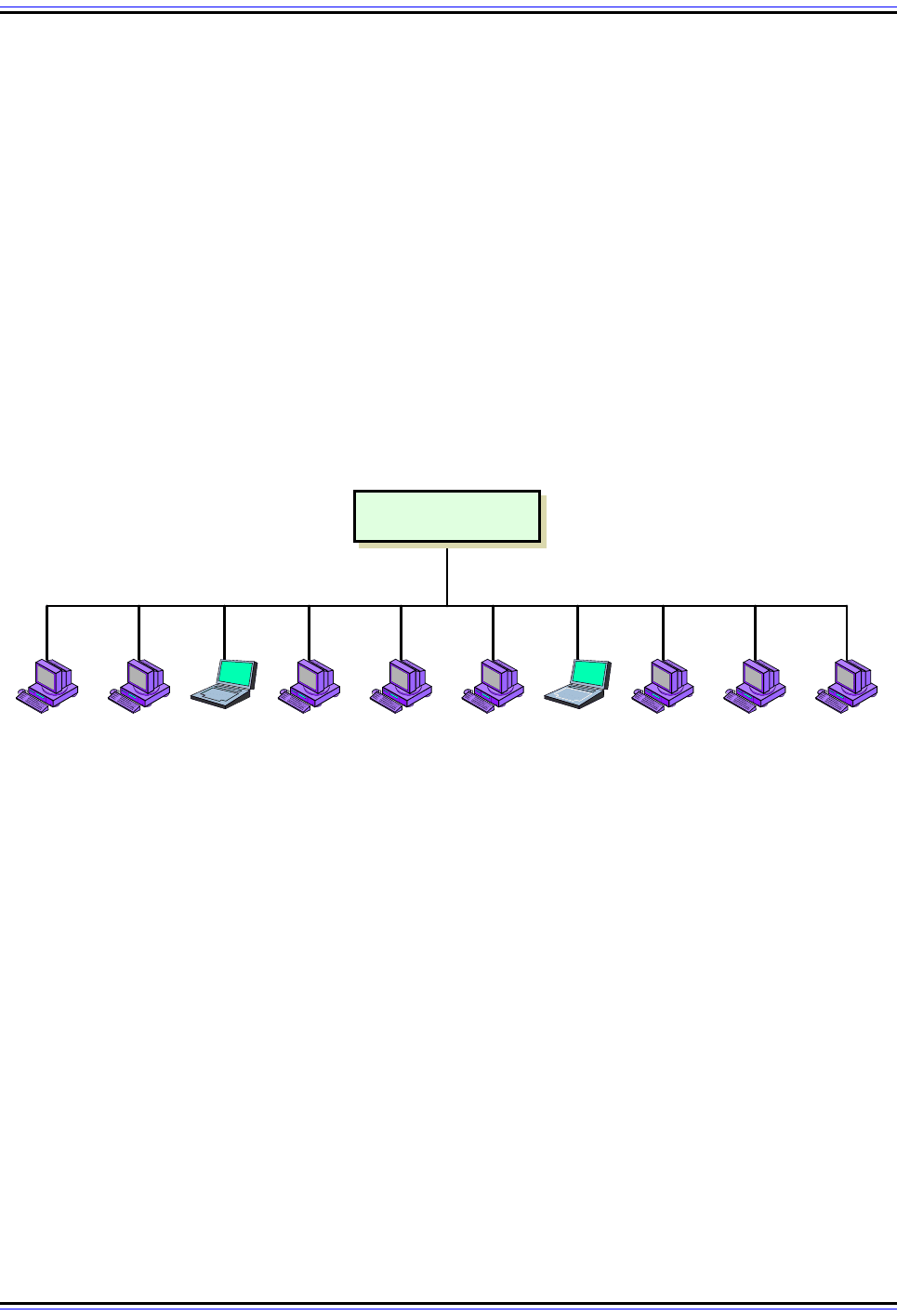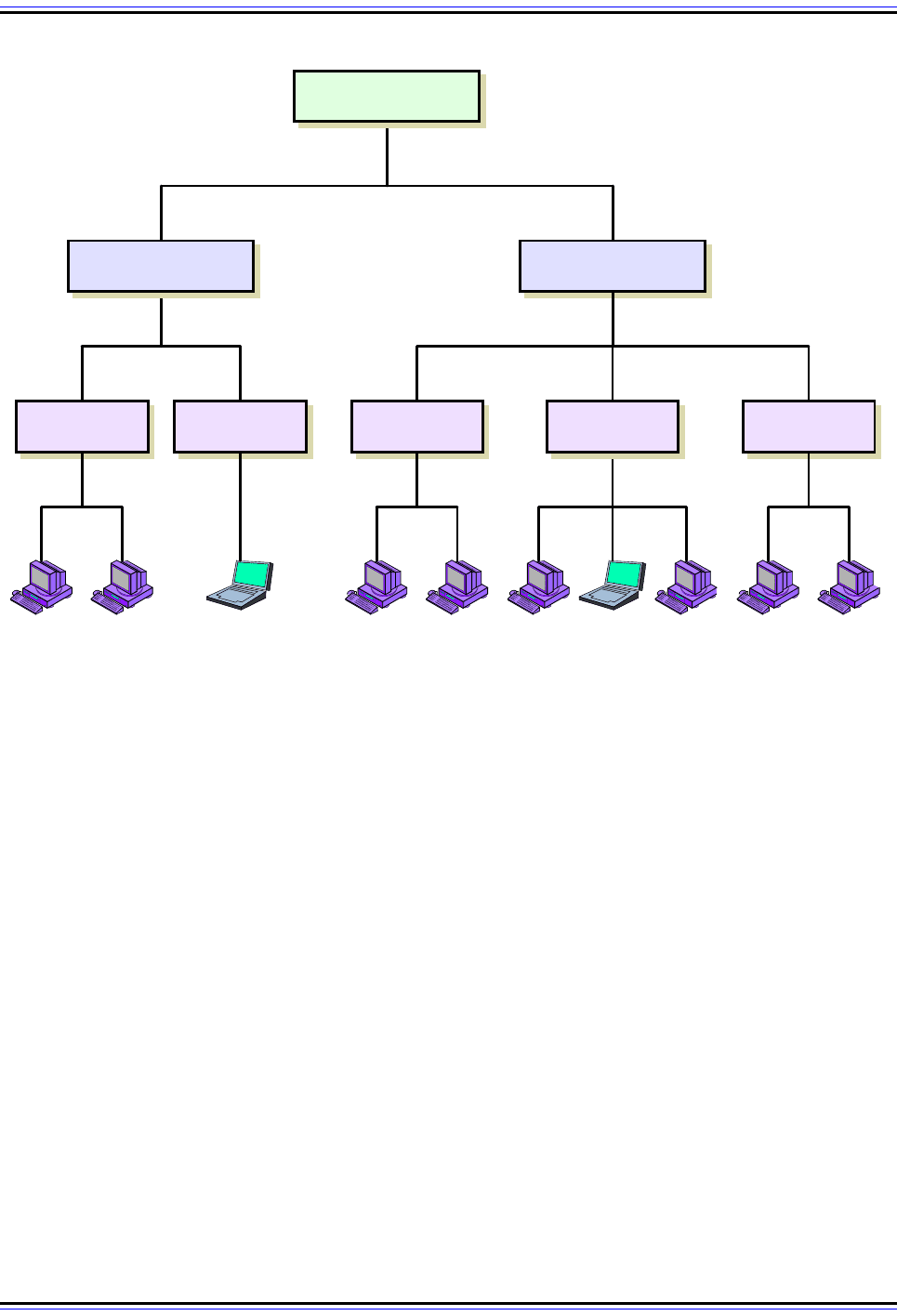Charles M. Kozierok The TCP-IP Guide
Подождите немного. Документ загружается.


The TCP/IP Guide - Version 3.0 (Contents) ` 951 _ © 2001-2005 Charles M. Kozierok. All Rights Reserved.
larger ones. The best example of this is the upcoming change to the Internet Protocol.
While DNS is important for the 32-bit addresses used in IP version 4, it's even more
important for dealing with the enormous 128-bit addresses of IP version 6.
Figure 230: Internetwork Access With A Name System
When an internetwork is equipped with a name system, the user no longer needs to know the address of a
device to access it. He or she enters the name and the name system converts it into an address automatically,
like a computerized “rolodex”, as I have shown here. ☺ The name system then passes the address to the
client software which uses that address to access the requested resource as if the user had entered it directly.
Ente r Name
Human User Client Server
Request Resource
Process Request
Generate Reply
Process Reply
Access Resource
Name System
Process Name
Request
Resolve Name To
Address

The TCP/IP Guide - Version 3.0 (Contents) ` 952 _ © 2001-2005 Charles M. Kozierok. All Rights Reserved.
Key Concept: Networking name systems are important because they allow devices
to be assigned efficient numeric addresses, while still enabling humans to access
them using names that are easier to remember. Name systems become more
important as you increase the size of the network, the address or the user base. They are
also more essential when the user base is limited in skill or experience.
Name System Functions: Name Space, Name Registration and
Name Resolution
While the difference between numeric addresses and symbolic names is very significant to
the users of network devices, it's important to remember that both numbers and names
really serve the same basic purpose: device identification. Even when we use a name
system to make devices easier to access, the computers themselves will still normally need
to use the underlying numeric identifier. In essence, then, every device will end up with (at
least) two identifiers: a number and a name.
The fact that devices end up with multiple identifiers is what allows both people and their
machines to use the method of identification they prefer. However, it means that there must
be ways of managing the assignment of names to devices, and of converting between
them. A name system therefore involves more than just slapping names on computers. It
must be, in fact, a complete system that allows names to be used by the humans while
numbers continue to be used by the devices.
Overview of Basic Name System Functions
At the highest level, I consider a name system's jobs as encompassing these three basic
functions:
☯ Name Space: The name system defines a name space for the networking system
upon which it runs. The name space, also sometimes called a name architecture,
describes the rules for how names are structured and used. It also defines how the
name of one device is related to the names of other devices in the system, and how to
ensure that no invalid names are given that would cause problems with the system as
a whole.
☯ Name Registration: To implement the name system, a name must be assigned to
each device on the network. Like any addressing system, a name system cannot work
properly unless every name on the system is unique; we need some way of managing
how the names are assigned so the result is sensible. The process of linking specific
names to particular devices is usually called name registration.
☯ Name Resolution: As I mentioned above, even though humans like symbolic names,
computers usually have little use for them. It is necessary to define a mechanism by
which a device's symbolic name can be translated into its numeric address. This
process is usually called name resolution.

The TCP/IP Guide - Version 3.0 (Contents) ` 953 _ © 2001-2005 Charles M. Kozierok. All Rights Reserved.
Relationships Between Name System Functions
The name space is more of a “descriptive” function; it is a definition of how names work in
the system. Name registration and resolution are more “active” functions, with each name
system including one or more specific procedures for how these jobs are carried out. Name
registration and resolution are in some ways complements of each other, so certain regis-
tration techniques are most often associated with particular resolution methods. In turn, the
types of registration and resolution methods that are possible depends on the name space
and in particular its architecture. These relationships are shown in simplified form in Figure
231.
The processes of registration and resolution can be either quite plain or fairly complicated,
depending on the type of name system used. Simple name systems are largely manual in
operation, easy to understand and best used in smaller networks. Larger, more complex
networks and internetworks require more sophisticated methods of registration and
resolution, which work with less need for administrator intervention and scale better as new
machines are added to the network.
Figure 231: Name System Functions
This diagram shows the relationships between the three main functions of a name system. The name space
defines the structure of the name system and the rules for creating names. The name space is used as the
basis for the name registration method, which defines the mappings between names and addresses.When a
user wants to access a device by name, a name resolution method is used to consult the name space,
determine what address is associated with a name, and then convert the name to an address.
Name Space
Name Registration Name Resolution
Requests to Associate
Device Names
To Addresses
Name/Address
Mappings
Name Resolution
Requests and Replies
Name/Address
Mappings

The TCP/IP Guide - Version 3.0 (Contents) ` 954 _ © 2001-2005 Charles M. Kozierok. All Rights Reserved.
I should also point out that while I consider name registration and name resolution as
“functions” at the highest level, they are probably better thought of as sets of functions.
Name registration is necessarily tied into issues such as name system administration and
management, and understanding resolution requires that we look at a number of important
implementation issues in the areas of efficiency and reliability. The next few topics expand
on this overview by considering each of these three functions in more detail.
Key Concept: A name system consists of three theoretical high-level functions: the
name space, which describes how names are created and organized; the name
registration technique, which is used to set up relationships between names and
addresses; and the name resolution method, which is responsible for translating names to
addresses.
Name Spaces and Name Architectures (Flat and Hierarchical)
The main idea of a name system is to provide a way to identify devices using symbolic
names. Like any identification mechanism, before we can use the system we must define
the way that identification will be performed. Numeric addressing schemes (like IP
addresses) have rules for how addresses are created, and assign addresses to each
device from their address space. In a similar way, devices in a name system are given
names from the system's name space.
Name Space Functions
Of the three main functional components of a name system, the name space is the most
abstract. It is also the most fundamental part of the system, since it actually describes how
the names are created. There are several aspects to what the name space defines in a
name system:
☯ Name Size and Maximum Number of Names: The name space specifies the number
of characters (symbols) that comprise names. In so doing, it also defines the maximum
number of names that can appear in the system.
☯ Name Rules and Syntax: The name space specifies what characters or symbols are
allowed in a name. This is used to allow legal names to be chosen for all devices while
avoiding illegal names.
☯ Name Architecture and Semantics: Each name space uses a specific architecture
or structure, which describes how names are constructed and interpreted.
Name Architectures
The concepts of name size and name syntax are relatively straight-forward. The last item,
name architecture, is probably the most important differentiating characteristic of name
systems. For this reason, name spaces are sometimes even called name architectures.
The architecture of the name space determines whether names are assigned and used as

The TCP/IP Guide - Version 3.0 (Contents) ` 955 _ © 2001-2005 Charles M. Kozierok. All Rights Reserved.
a simple unstructured set of symbols, or whether they have a more complex internal
structure. In the latter case, the name space also must define how elements of a particular
name are related to each other.
Theoretically, many different name architectures are possible. In practice, most fall into one
of two categories: flat and hierarchical architectures.
Flat Name Architecture (Flat Name Space)
Names are assigned as a sequence of symbols that are interpreted as a single, whole label
without any internal structure. There is no clear relationship between any name and any
other name.
An example of this sort of architecture would be a name system where computers are given
unstructured names like “Engineering Workstation 1” or “Joanne's PC”, as shown in the
example in Figure 232.
Hierarchical Name Architecture (Hierarchical or Structured Name Space)
In this architecture, while names consist of a sequence of symbols, these symbols are
assigned using a specific and clear structure. The name consists of discrete elements that
are related to each other usually using hierarchical “parent/child” semantics. There are
many naming architectures in various contexts that use this type of hierarchical structure;
for example, consider how a large company might set up an organization chart and name
the executives and officers in the organization. One hypothetical example of a hierarchical
name architecture is illustrated in Figure 233.
The best-known real world example of a hierarchical name space is the name space of the
TCP/IP Domain Name System, which uses text labels separated by periods (“dots”) to form
an internal structure. All the names in the system are organized into a structure, and a
Figure 232: Flat Name Architecture (Flat Name Space)
This diagram shows an example of a flat name architecture. There is no structure that organizes the names or
dictates how they must be constructed. Logically, each device is a peer of each of the others.
XYZ Industries
Jo In Sales
Jose's PC
Jaclyn
Jean, France
Jalil's Machine
Julie J.
John's Notebook
Jill
EU-Service-Jorge
Jae's PC

The TCP/IP Guide - Version 3.0 (Contents) ` 956 _ © 2001-2005 Charles M. Kozierok. All Rights Reserved.
particular device's place in the structure can be determined by looking at its name. For
example, “www.tcpipguide.com” refers to the World Wide Web server for The TCP/IP
Guide, which is named under the umbrella of “COMmercial” companies.
Comparing Name Architectures
As we will see in the next two topics, the architecture of the name space is intimately related
to how names are registered and managed, and ultimately, how they are resolved as well. A
flat name space requires a central authority of some sort to assign names to all devices in
the system to ensure uniqueness. A hierarchical name architecture is ideally suited to a
more distributed registration scheme that allows many authorities to share in the regis-
tration and administrative process.
Figure 233: Hierarchical Name Architecture (Structured Name Space)
This diagram contains the same devices as Figure 232, but they have been arranged using a hierarchical,
structured name architecture. In this case, the organization has chosen to structure its device names first by
facility location, and then by department. Each name starts with something like “USA-Service-” or “EU-Mfg-”.
This provides immediate benefits by providing local control over device naming without risk of conflicts. If
someone named John were hired into the USA sales force, his machine could be named “US-Sales-John”
without conflicting with the machine owned by John of the European sales force (“EU-Sales-John”.) The
structure also makes it easier to know immediately where a device can be found within the organization.
XYZ Industries
United States
Operation
European Union
Operations
USA-ServiceUSA-Sales EU-Mfg EU-Sale s EU-Service
USA-Sales-Jo
USA-Sales-Jose
USA-Service-Jaclyn
EU-Mfg-Jean
EU-Mfg-Jalil
EU-Sales-Julie
EU-Sales-John
EU-Sales-Jill
EU-Service-Jorge
EU-Service-Jae

The TCP/IP Guide - Version 3.0 (Contents) ` 957 _ © 2001-2005 Charles M. Kozierok. All Rights Reserved.
All of this means that the advantages and disadvantages of each of these architectures are
not a great mystery. Flat name spaces have the advantage of simplicity and the ability to
create short and easily remembered names, as shown in Figure 232. However, they do not
scale well to name systems containing hundreds or thousands of machines, due to the diffi-
culties in ensuring each name is unique. For example, what happens if there are four
people named John who all try to name their computers “John’s PC”? Another issue is the
overhead needed to centrally manage these names.
In contrast, hierarchical name spaces are more sophisticated and flexible, because they
allow names to be assigned using a logical structure. We can name our machines using a
hierarchy that reflects our organization’s structure, for example, and give authority to
different parts of the organization to manage parts of the name space. As long as each
department is named uniquely and that unique department name is part of each machine
name, we don’t need to worry about each assigned name being unique across the entire
organization, only within the department. Thus we can have four different machines named
with their department name and “John”, as Figure 233 demonstrates. The price of this flexi-
bility is the need for longer names and more complexity in name registration and resolution.
Key Concept: The two most common types of name architecture are the flat name
space and the hierarchical name space. Names in a flat name space are all peers
with no relationship; in a hierarchical architecture, a multi-level structure is used to
organize names in a specific way. The flat system is simpler and satisfactory for small
networks, while the hierarchical name space is more flexible and powerful, and better-
suited to larger networks and internetworks.
Name Registration Methods, Administration and Authorities
It seems obvious that for our name system to be implemented, we need some method of
assigning names to each of the devices that will use the system. Just as a name system
has a name space that is comparable to an addressing system's address space, it also
must implement a set of rules and procedures for assigning names, just as an addressing
system assigns addresses. This is called name registration.
Name Registration Functions
In general, name registration encompasses the following concepts and tasks:
☯ Name Assignment and Guaranteeing Uniqueness: The core task of the name
registration process is of course assigning names to devices. Like all identification
schemes, a key requirement of name registration is ensuring that each name is
unique. Duplicated names cause ambiguity and make consistent name resolution
impossible.

The TCP/IP Guide - Version 3.0 (Contents) ` 958 _ © 2001-2005 Charles M. Kozierok. All Rights Reserved.
☯ Central Registration Authority Designation: Ensuring uniqueness of names
requires that there be someone “in charge” of the name assignment process. This
central registration authority may be a single individual that maintains a file containing
names, or an organization that is responsible for the overall name registration process.
The authority is also charged with resolving problems and conflicts that may arise in
registrations.
☯ Registration Authority Delegation: In smaller name systems, the central registration
authority may be responsible for the actual registration process for all devices. In
larger, hierarchical name systems, having this process centralized is impractical.
Instead, the central registration authority will divide the name space and delegate
authority for registering names in different parts of it to subordinate organizations. This
requires a delegation policy to be developed and implemented.
☯ Defining Hierarchical Structure: When a hierarchical name space is used, the
central authority is responsible for defining how the structure will look. This in turn
dictates how names can be registered in different parts of the hierarchy, and of course,
also impacts how authority is delegated.
Impact of Name Space Architecture on Name Registration
The complexity of the name registration process depends to a great extent on the size and
complexity of the name system as a whole, and in particular the architecture of the name
space. In a simple name system using a flat name space, registration is usually accom-
plished using a single authority. There is no structure, of course, and usually no delegation
of authority, so there isn't much to registration.
For hierarchical name systems, name registration is tied tightly to the hierarchy used for
names. The central authority defines the structure of the hierarchy, and decides how the
hierarchy is to be partitioned into subsets that can be independently administered by other
authorities. Those authorities may in turn delegate subsets of their name spaces as well,
creating a flexible and extensible system.
This ability to delegate authority for name registration is one of the most powerful benefits of
a hierarchical name space. For example, in the TCP/IP Domain Name System, a central
authority is responsible for name registration as a whole; it is in charge of deciding what
top-level domains, such as “.com”, “.edu”, “.info” and “.uk” are allowed to exist. Authority for
managing each of these subsets of the worldwide hierarchy is then delegated to other
organizations. These organizations continue the process of dividing the hierarchy as they
see fit. Eventually each organization is able to decide how it will name its own internal
systems independently; for example, IBM can register names in any way it sees fit within
the “ibm.com” name.
Name Registration Methods
There are several common methods by which the actual process of registration is carried
out. Each of these has its strengths and weaknesses, and again, some are better-suited to
flat name spaces and some to hierarchical ones.

The TCP/IP Guide - Version 3.0 (Contents) ` 959 _ © 2001-2005 Charles M. Kozierok. All Rights Reserved.
Table Name Registration
In this technique, name assignments are maintained in a table by an administrator. When
names need to be added, deleted or changed the table is edited.
This technique is usually associated with small, flat name space name systems, and has
the same benefits and drawbacks as flat architecture in general: it is simple and easy to
implement, but doesn't scale well to larger systems. With a dozen machines, having
someone edit name registration tables is practical; with thousands of machines it is not. It is
also not conducive to a hierarchical system where there are multiple authorities, because
the table needs to be kept in one place.
In larger internetworks, tables may be used as an adjunct to one of the more sophisticated
techniques below.
Broadcast Name Registration
This is a “trial and error” technique; a device that wants to use a particular name sends out
a message to all other devices on the network asking to see if anyone else is already using
it. If so, it chooses a different name. If not, the name is considered registered and can then
be used.
This technique is more sophisticated than using tables, but is still limited to use in relatively
small systems. It is not practical to attempt to broadcast to thousands of systems, and this
method could not be used over the Internet, since there is no way to broadcast to every
device on an internetwork.
Database Registration
A database of name assignments is maintained. To register a name, a request must be
made to have the name assignment added to the database. If the authority for the name
system is entirely centralized, the database will be centralized and maintained by that
authority. If authority for parts of the hierarchy is delegated, then a distributed database is
used for registration, with each authority maintaining the part of the database describing
their section of the hierarchy.
This is the most sophisticated technique, and one normally associated with hierarchical
name systems like DNS. It has several benefits, including flexibility, reliability and distri-
bution of maintenance effort; its main drawback is complexity.
Key Concept: Name registration is the process by which names are linked to
addresses in a name system. It encompasses activities such as central registry
authority designation and delegation, and name space structure management. The
most common methods of name registration, in order of both increasing capability and
complexity, are manual table maintenance, broadcast registration and database
registration.

The TCP/IP Guide - Version 3.0 (Contents) ` 960 _ © 2001-2005 Charles M. Kozierok. All Rights Reserved.
We have just seen that the choice of name space and architecture immediately has an
important impact on how name registration is done. The next topic will show how name
resolution is closely related to name registration and architecture as well.
Name Resolution Techniques and Functional Elements of A Name
Resolution System
As we discussed earlier in this section, using a name system creates two “parallel” identifi-
cation systems for computers: the numbers used by machines and the names used by
people. The job of the name system is to integrate these two schemes. Name registration
allows humans to specify which machines use which names. This is only half the process,
however; we also need a way for machines to take a name given to them by a human and
translate it into the “real” address it can actually use for communication. This is called name
resolution.
Name resolution, also sometimes called name translation, mapping or binding, is the most
well-known aspect of name systems, because it is where most of the “heavy lifting” of a
name system occurs. The name space is generally set up once, and name registration
occurs infrequently: only when names must be created or changed. In contrast, every user
of a name system instructs the machines he or she uses to perform name resolution,
hundreds or even thousands of times a day.
Name Resolution Methods
There are several different techniques that can be use for name resolution. How this
function is implemented depends a great deal on the other two name system functions,
name space and name registration. As you might imagine, a simple name system with a
simple name registration method will most often use a simple resolution method as well.
Complex hierarchical systems with distributed databases require more sophistication in
how names are resolved.
There are three common name resolution methods.
Table Name Resolution
The table used for table-based name registration is consulted by a device when resolution
needs to be performed. The table tells the device how to transform the name of the
machine it needs to contact into an address.
This technique obviously corresponds to table name registration; it is the simplest and least
capable of the three methods. Table name resolution is suitable for standalone use only in
very small name systems, but can be a supplement to other methods as well.
Broadcast Name Resolution
When a device needs to resolve a name, it broadcasts a query that says something to this
effect: “I need to send to the device named 'X', who is that?” The device whose name is 'X'
responds back saying “I'm 'X' and my numeric address is 'N'”.
